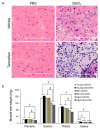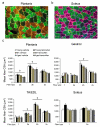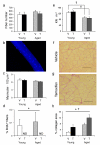Inducible depletion of satellite cells in adult, sedentary mice impairs muscle regenerative capacity without affecting sarcopenia
- PMID: 25501907
- PMCID: PMC4289085
- DOI: 10.1038/nm.3710
Inducible depletion of satellite cells in adult, sedentary mice impairs muscle regenerative capacity without affecting sarcopenia
Abstract
A key determinant of geriatric frailty is sarcopenia, the age-associated loss of skeletal muscle mass and strength. Although the etiology of sarcopenia is unknown, the correlation during aging between the loss of activity of satellite cells, which are endogenous muscle stem cells, and impaired muscle regenerative capacity has led to the hypothesis that the loss of satellite cell activity is also a cause of sarcopenia. We tested this hypothesis in male sedentary mice by experimentally depleting satellite cells in young adult animals to a degree sufficient to impair regeneration throughout the rest of their lives. A detailed analysis of multiple muscles harvested at various time points during aging in different cohorts of these mice showed that the muscles were of normal size, despite low regenerative capacity, but did have increased fibrosis. These results suggest that lifelong reduction of satellite cells neither accelerated nor exacerbated sarcopenia and that satellite cells did not contribute to the maintenance of muscle size or fiber type composition during aging, but that their loss may contribute to age-related muscle fibrosis.
Figures




References
-
- Bortz WM., 2nd A conceptual framework of frailty: a review. J Gerontol A Biol Sci Med Sci. 2002;57:M283–288. - PubMed
-
- Garcia-Prat L, Sousa-Victor P, Munoz-Canoves P. Functional dysregulation of stem cells during aging: a focus on skeletal muscle stem cells. FEBS J. 2013;280:4051–4062. - PubMed
-
- Gopinath SD, Rando TA. Stem cell review series: aging of the skeletal muscle stem cell niche. Aging Cell. 2008;7:590–598. - PubMed
-
- Topinkova E. Aging, disability and frailty. Ann Nutr Metab. 2008;52(Suppl 1):6–11. - PubMed
Online Methods References
Publication types
MeSH terms
Grants and funding
LinkOut - more resources
Full Text Sources
Other Literature Sources
Medical
Molecular Biology Databases

